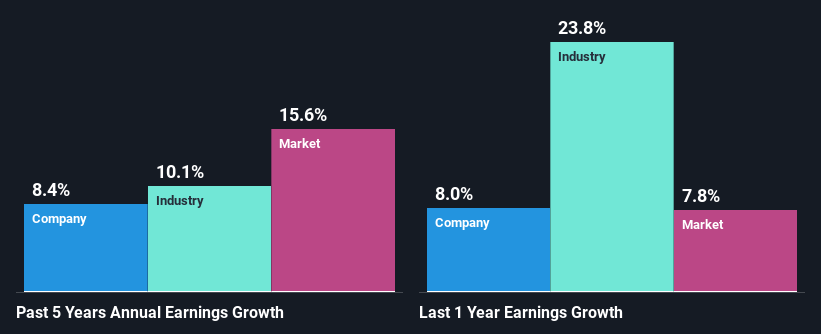Is Weakness In Emerson Electric Co. (NYSE:EMR) Stock A Sign That The Market Could be Wrong Given Its Strong Financial Prospects?
With its stock down 13% over the past three months, it is easy to disregard Emerson Electric (NYSE:EMR). However, a closer look at its sound financials might cause you to think again. Given that fundamentals usually drive long-term market outcomes, the company is worth looking at. Specifically, we decided to study Emerson Electric's ROE in this article.
ROE or return on equity is a useful tool to assess how effectively a company can generate returns on the investment it received from its shareholders. In simpler terms, it measures the profitability of a company in relation to shareholder's equity.
View our latest analysis for Emerson Electric
How Do You Calculate Return On Equity?
ROE can be calculated by using the formula:
Return on Equity = Net Profit (from continuing operations) ÷ Shareholders' Equity
So, based on the above formula, the ROE for Emerson Electric is:
17% = US$2.8b ÷ US$17b (Based on the trailing twelve months to December 2022).
The 'return' refers to a company's earnings over the last year. So, this means that for every $1 of its shareholder's investments, the company generates a profit of $0.17.
What Is The Relationship Between ROE And Earnings Growth?
So far, we've learned that ROE is a measure of a company's profitability. Depending on how much of these profits the company reinvests or "retains", and how effectively it does so, we are then able to assess a company’s earnings growth potential. Assuming everything else remains unchanged, the higher the ROE and profit retention, the higher the growth rate of a company compared to companies that don't necessarily bear these characteristics.
Emerson Electric's Earnings Growth And 17% ROE
To begin with, Emerson Electric seems to have a respectable ROE. Even when compared to the industry average of 16% the company's ROE looks quite decent. This probably goes some way in explaining Emerson Electric's moderate 8.4% growth over the past five years amongst other factors.
We then performed a comparison between Emerson Electric's net income growth with the industry, which revealed that the company's growth is similar to the average industry growth of 10% in the same period.
Earnings growth is a huge factor in stock valuation. It’s important for an investor to know whether the market has priced in the company's expected earnings growth (or decline). This then helps them determine if the stock is placed for a bright or bleak future. Is EMR fairly valued? This infographic on the company's intrinsic value has everything you need to know.
Is Emerson Electric Using Its Retained Earnings Effectively?
The high three-year median payout ratio of 52% (or a retention ratio of 48%) for Emerson Electric suggests that the company's growth wasn't really hampered despite it returning most of its income to its shareholders.
Additionally, Emerson Electric has paid dividends over a period of at least ten years which means that the company is pretty serious about sharing its profits with shareholders. Our latest analyst data shows that the future payout ratio of the company over the next three years is expected to be approximately 45%. Still, forecasts suggest that Emerson Electric's future ROE will drop to 13% even though the the company's payout ratio is not expected to change by much.
Summary
Overall, we are quite pleased with Emerson Electric's performance. In particular, its high ROE is quite noteworthy and also the probable explanation behind its considerable earnings growth. Yet, the company is retaining a small portion of its profits. Which means that the company has been able to grow its earnings in spite of it, so that's not too bad. With that said, the latest industry analyst forecasts reveal that the company's earnings growth is expected to slow down. Are these analysts expectations based on the broad expectations for the industry, or on the company's fundamentals? Click here to be taken to our analyst's forecasts page for the company.
Have feedback on this article? Concerned about the content? Get in touch with us directly. Alternatively, email editorial-team (at) simplywallst.com.
This article by Simply Wall St is general in nature. We provide commentary based on historical data and analyst forecasts only using an unbiased methodology and our articles are not intended to be financial advice. It does not constitute a recommendation to buy or sell any stock, and does not take account of your objectives, or your financial situation. We aim to bring you long-term focused analysis driven by fundamental data. Note that our analysis may not factor in the latest price-sensitive company announcements or qualitative material. Simply Wall St has no position in any stocks mentioned.
Join A Paid User Research Session
You’ll receive a US$30 Amazon Gift card for 1 hour of your time while helping us build better investing tools for the individual investors like yourself. Sign up here

 Yahoo Finance
Yahoo Finance 
